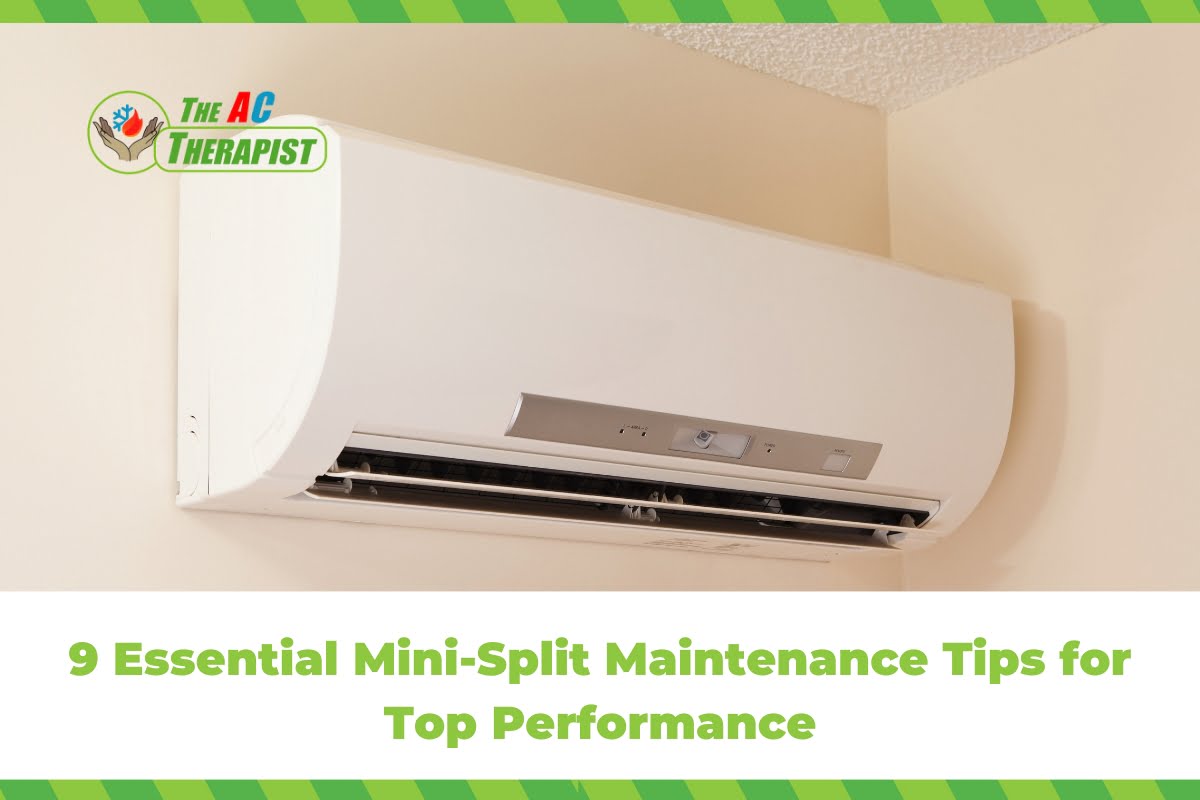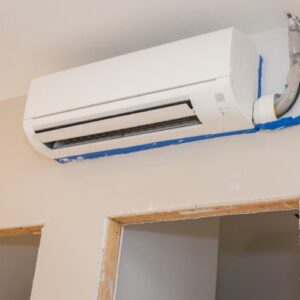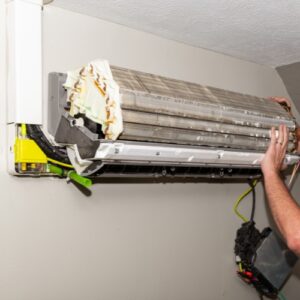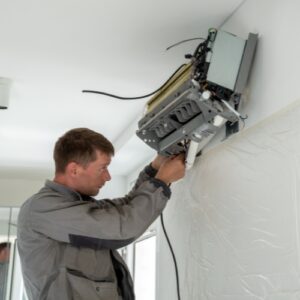9 Essential Mini-Split Maintenance Tips for Top Performance
In the realm of residential and light commercial cooling systems, mini-split air conditioners stand out as a compelling option for those seeking efficiency, versatility, and cost-effective operation. These systems, characterized by their split design involving an outdoor compressor unit and one or more indoor air-handling units, offer a ductless solution to air conditioning, making them ideal for a wide range of spaces from older homes without ductwork to new additions and small apartments.
Unlike traditional central air systems, mini-splits provide targeted cooling and heating, allowing users to control temperatures in specific zones or rooms, which enhances comfort and reduces energy consumption. With higher SEER (Seasonal Energy Efficiency Ratio) ratings than many conventional systems, mini-splits are not only energy-efficient but also environmentally friendly, often using the latest in eco-friendly refrigerant technology.
This guide will delve into what mini-split air conditioners are, explore their numerous benefits, and offer essential tips on how to maintain your system for optimal performance and longevity. Whether you’re installing a new system or maintaining an existing one, understanding how to operate and care for your mini-split effectively will ensure it continues to provide comfortable and efficient service for years to come.
Understanding Mini-Split Air Conditioners
Mini-split air conditioners are a modern cooling and heating solution that caters to the specific needs of homeowners and business operators who require flexible and efficient temperature control. This section will help demystify how mini-splits work, their key components, and why they might be the right choice for your air conditioning needs.
Key Components
A mini-split system typically consists of two primary parts: the outdoor unit and one or more indoor units. These components are connected by a conduit that houses the power cable, refrigerant tubing, suction tubing, and a condensate drain.
- Outdoor Unit: This contains the compressor, condenser coil, and expansion coil or capillary tubing. It is installed outside the home or building and is responsible for expelling heat from the indoor air.
- Indoor Unit: Each indoor unit contains an evaporator coil and a fan. It is typically mounted on the wall or ceiling and delivers conditioned air directly into the space. Unlike traditional central air systems, each unit can be controlled independently, allowing for customized temperature settings in each room.
How It Works
The process begins when the indoor unit draws in warm room air and passes it over the cold evaporator coil. The refrigerant in the coil absorbs heat from the air, cooling it before it is blown back into the room. The refrigerant, now carrying the absorbed heat, travels through a closed system of tubing to the outdoor unit where it is compressed and its temperature is raised. Finally, the outdoor unit releases the absorbed heat to the outside air through the condenser coil.
Advantages of Mini-Split Systems
Mini-splits offer several distinct advantages that make them an attractive option for many property owners:
- No Ductwork Required: The lack of ductwork reduces energy losses associated with ducted systems, where leaks and thermal transfer can significantly decrease efficiency. This makes mini-splits particularly suitable for renovations, extensions, or older buildings where installing ductwork is impractical or too costly.
- Individual Control: Each indoor unit can be controlled independently, allowing for personal comfort settings in each zone or room. This not only enhances comfort but also allows for energy savings as unoccupied rooms need not be heated or cooled unnecessarily.
- Installation Flexibility: Mini-splits can be installed virtually anywhere due to their compact size and flexibility in terms of unit placement. Indoor units can be wall-mounted, ceiling-mounted, or even recessed depending on the specific needs and aesthetic preferences.
- Quiet Operation: The indoor units of mini-splits are remarkably quiet, typically producing less noise than a standard refrigerator, making them ideal for environments where noise is a concern, such as bedrooms, offices, and libraries.
- Energy Efficiency: With advanced inverter technology, mini-splits adjust the speed of the compressor to the demand for heating or cooling, which conserves energy and maintains more consistent indoor temperatures without the frequent on-off cycling of traditional HVAC systems.
Benefits of Mini-Split Air Conditioners
Mini-split air conditioners offer a host of advantages that make them a preferred choice for both residential and light commercial applications. Their unique design and functionality bring forth several benefits that enhance comfort, reduce energy consumption, and provide flexible installation options. Here are some of the key benefits of mini-split air conditioners:
1. Energy Efficiency
Mini-split systems are renowned for their high Seasonal Energy Efficiency Ratio (SEER) ratings. Because they don’t require ductwork, they avoid the energy losses associated with ducted systems, where up to 30% of energy can be lost due to leaks and conduction in the ductwork. Additionally, the inverter technology in many mini-splits adjusts the speed of the compressor to the demand, which minimizes unnecessary energy usage and helps maintain more consistent temperatures.
2. Customized Comfort
Each indoor unit operates independently and can be controlled separately. This means you can set different temperatures in different rooms or zones according to individual preferences and usage patterns. This level of control not only enhances comfort but also contributes to energy savings, as you can reduce heating or cooling in unused areas.
3. Versatile Installation
Mini-splits can be installed in a variety of settings due to their compact size and flexible installation options. The indoor units can be mounted on walls, suspended from ceilings, or even installed as floor-standing units, depending on the layout and design of the space. This makes them an excellent option for older buildings, new additions, or areas where traditional ducted HVAC systems would be too cumbersome or expensive to install.
4. Improved Air Quality
Mini-split systems generally have multi-stage filtration features that reduce dust, bacteria, pollen, allergens, and other particulates in the air. Since each unit handles air locally, there’s less chance of cross-contamination of air from room to room, which can be particularly beneficial in homes with allergy sufferers or environments requiring higher air quality.
5. Quiet Operation
The noise level of indoor units of mini-split systems is significantly lower compared to traditional HVAC systems. Most units operate at a noise level comparable to a whisper, making them ideal for environments such as bedrooms, offices, libraries, and places where maintaining a quiet atmosphere is crucial.
6. Minimal Visual Impact
Modern mini-split systems are designed with aesthetics in mind. They come in sleek, compact designs that can blend seamlessly into the decor or stand out as a modern feature, depending on the user’s preference. Additionally, the absence of ductwork means there’s no need for bulky vents or air registers, which can disrupt the visual flow of a room.
7. Reduced Environmental Impact
Mini-splits use the latest refrigerants that have a lower impact on the ozone layer and global warming. Their increased energy efficiency also translates into a smaller carbon footprint, making them a more environmentally friendly choice compared to traditional systems.
8. Longevity and Durability
With proper maintenance, mini-split systems can have a long operational life, providing reliable heating and cooling for many years. Their design minimizes wear and tear on components by allowing the compressor to operate at varying speeds, which can extend the lifespan of the system compared to traditional systems that turn on and off more frequently.
The benefits of mini-split air conditioners are compelling, making them an excellent choice for anyone looking to improve their heating and cooling efficiency, reduce their environmental impact, and enhance the comfort and air quality of their indoor environments. Whether for a home, office, or commercial space, mini-splits offer a versatile, efficient, and aesthetically pleasing solution for modern air conditioning needs.
Maintenance Tips for Mini-Split Air Conditioners
Proper maintenance is crucial for ensuring that your mini-split air conditioner operates efficiently and lasts as long as possible. Regular upkeep not only helps in maintaining performance but also prevents common problems that could lead to costly repairs. Here are some essential maintenance tips to keep your mini-split system in top condition:
1. Clean or Replace Filters Regularly
One of the simplest yet most effective maintenance tasks is to clean the air filters in the indoor units. Dust and debris can clog these filters, hindering airflow and reducing efficiency. Most mini-split systems have washable filters that should be cleaned every month. Check the manufacturer’s guidelines for specific recommendations on cleaning or replacing the filters to ensure optimal air quality and system performance.
2. Inspect and Clean the Outdoor Unit
The outdoor unit of a mini-split system should be kept clear of leaves, dirt, and debris. These can obstruct the heat exchange process and strain the system, leading to inefficiencies and potential malfunctions. Ensure there’s at least two feet of clearance around the unit. Periodically, inspect the unit for any buildup of dirt or debris and gently clean the exterior with a soft brush or cloth.
3. Check and Clear the Condensate Drain
The condensate drain can become clogged with algae, mold, or dirt, which might cause water to back up and potentially damage the system or lead to leaks inside your home. Check the drain periodically to ensure it is clear and draining properly. If necessary, flush the line with a mild bleach solution to remove any blockages.
4. Ensure Proper Refrigerant Levels
Refrigerant is essential for the cooling process, but levels can drop due to leaks or other system issues. Since improper refrigerant levels can significantly reduce efficiency and increase energy costs, it is advisable to have a professional technician check the refrigerant levels annually and repair any leaks.
5. Regularly Service the System
Scheduling a professional maintenance service at least once a year is vital. A qualified technician can perform a thorough inspection and service of your mini-split system. This includes checking electrical connections, ensuring all components are functioning correctly, cleaning coils, and verifying that the system operates efficiently.
6. Keep Indoor Units Clean
Dust and dirt can also accumulate on the surfaces of your indoor units. Keep these clean by gently wiping the exterior with a dry or slightly damp cloth. Avoid using harsh cleaners or abrasive tools that might damage the surface.
7. Review and Adjust Settings Regularly
Periodically review the settings on your mini-split system to ensure they are optimized for current conditions. Adjusting the settings as needed can help save energy and reduce wear and tear on the system.
8. Listen for Unusual Noises
Be attentive to any unusual sounds coming from either the indoor or outdoor units. Noises such as rattling, buzzing, or whirring can indicate loose parts, obstructions, or other issues that might require professional attention.
9. Monitor System Performance
Keep an eye on your system’s performance. If you notice a decrease in cooling or heating efficiency, or if the system seems to be running more frequently than usual, it could indicate a problem that needs addressing.
DIY Maintenance Guidelines for Homeowners: Caring for Your Mini-Split Air Conditioner
Maintaining your mini-split air conditioner doesn’t always require professional help. There are several maintenance tasks that homeowners can safely and effectively perform themselves to keep their system running smoothly. Here’s a practical guide to help you handle routine maintenance:
1. Cleaning the Air Filters
- Frequency: Monthly
- Steps:
- Turn off the power to the unit.
- Open the front panel of the indoor unit to access the filter.
- Carefully remove the filter. Most filters slide out easily.
- Vacuum the filters gently to remove dust and loose particles.
- Wash the filters with warm water and mild detergent if they are very dirty. Rinse thoroughly until the water runs clear.
- Let the filters dry completely in a shaded area before reinstalling them.
- Replace the filters and close the front panel.
2. Keeping the Outdoor Unit Clear
- Frequency: Every 2-3 months, more frequently in fall and windy conditions.
- Steps:
- Ensure the unit is switched off before you begin.
- Remove any leaves, twigs, or debris around and on top of the unit.
- Check for any plants growing too close to the unit and trim them back.
- Gently brush off any dirt or debris on the coil and surrounding areas with a soft brush.
- If needed, gently hose down the outdoor unit to remove dust and improve efficiency.
3. Checking the Condensate Drain
- Frequency: Every 6 months
- Steps:
- Locate the condensate drain line; this is usually a small PVC pipe coming from the indoor unit.
- Check for any visible clogs or algae growth.
- Use a wet/dry vacuum to suck any blockages out from the drain outlet.
- Flush the line with a vinegar solution (1 part vinegar to 1 part water) to kill any mold or mildew.
4. Inspecting Electrical Connections
- Frequency: Annually
- Note: This task is more technical and should only be done if you are comfortable with basic electrical work.
- Steps:
- Turn off the power to the unit at the breaker.
- Remove the access panel on the outdoor unit.
- Check for any loose wires or corroded terminals.
- Tighten connections and apply electrical contact cleaner if necessary.
- Replace the access panel and restore power.
5. Monitoring and Adjusting Settings
- Frequency: As needed
- Steps:
- Regularly check the thermostat settings to ensure they are appropriate for the current weather conditions.
- Adjust the temperature settings according to your daily schedule for optimal comfort and energy efficiency.
- Make use of timers and sleep functions to reduce energy consumption when the system is not needed.
Safety Tips
- Always ensure the power is turned off before performing any maintenance tasks.
- Use a sturdy ladder when accessing components that are out of reach.
- Wear protective gloves and eyewear when cleaning coils and handling potentially sharp metallic parts.
Mastering Mini-Split Maintenance: Essential DIY Tips from The AC Therapist
As The AC Therapist, I know how crucial it is to maintain the efficiency and longevity of your mini-split air conditioning system. Over the years, I’ve guided numerous homeowners through the process, helping them understand the importance of regular maintenance to ensure their system performs at their best. Through these experiences, I’ve gathered a wealth of knowledge on how to effectively care for these systems, knowledge that I’m eager to pass on to you.
Maintaining your mini-split doesn’t just prevent costly breakdowns and ensures that your system operates at peak efficiency, saving you money on energy bills and reducing environmental impact. The DIY maintenance tips I’ve shared today are designed to empower you as a homeowner. By taking proactive steps like cleaning filters, inspecting the outdoor unit, and monitoring your system’s settings, you can significantly extend the life of your air conditioner and maintain optimal comfort in your home.
Remember, while many maintenance tasks are simple and can be done independently, don’t hesitate to reach out for professional help when needed. Whether it’s checking refrigerant levels or dealing with electrical components, sometimes calling in an expert is the best course of action.
Stay vigilant, stay informed, and remember, that your mini-split system is a key component of your home’s comfort. Treat it well, and it will continue to provide reliable cooling and heating for years to come. And remember, if the task seems daunting or you’re unsure of how to proceed, The AC Therapist is always here to help guide you through any issues you may encounter. Together, we can ensure that your home remains a sanctuary of comfort, regardless of the weather outside. Stay cool, stay comfortable, and as always, trust The AC Therapist for all your HVAC needs!












